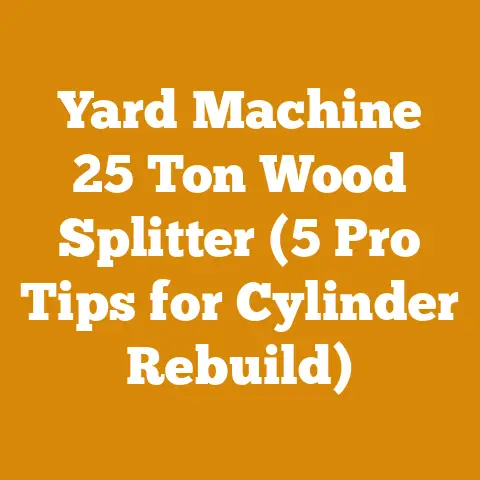Retaining Wall Using H Beams (5 Pro Tips for Waterlogged Sites)
The tradition of building with earth and timber runs deep in our bones.
For generations, folks have been finding clever ways to hold back the land, to tame slopes and create usable space.
Retaining walls, in particular, are a testament to human ingenuity, and when the ground gets soggy, that ingenuity needs to crank up a notch.
I’ve spent years wrestling with waterlogged sites, and I can tell you, the standard approaches often fall short.
That’s why I’m excited to share my insights on using H beams for retaining walls in these challenging environments.
It’s a system that combines strength, durability, and, with a few smart tweaks, excellent drainage.
So, let’s dive into how to build a retaining wall using H beams, focusing on those crucial pro tips for waterlogged sites.
Retaining Wall Using H Beams (5 Pro Tips for Waterlogged Sites)
Building a retaining wall, especially in a waterlogged area, requires careful planning and execution.
The inherent instability of saturated soil can put immense pressure on the wall, leading to failure if not properly addressed.
Using H beams offers a robust solution, but the key lies in understanding how to mitigate the effects of water.
Why H Beams for Retaining Walls?
H beams, also known as I beams in some regions, provide exceptional strength and resistance to bending.
Their shape allows them to withstand significant lateral pressure, making them ideal for retaining walls.
- High Strength-to-Weight Ratio: H beams offer a great deal of strength without being excessively heavy, simplifying installation.
- Durability: Steel H beams, especially when treated with protective coatings, can last for decades, even in harsh environments.
- Versatility: They can be easily adapted to various wall heights and soil conditions.
- Ease of Installation: While requiring specialized equipment, the installation process is relatively straightforward compared to some other retaining wall systems.
Understanding the Challenges of Waterlogged Sites
Before I get into the specifics of building a wall, let’s talk about why waterlogged sites are so tricky.
It’s all about hydrostatic pressure.
- Increased Lateral Pressure: Waterlogged soil exerts significantly higher lateral pressure on the wall compared to dry soil.
Imagine the difference between pushing against a pile of dry sand versus pushing against a swimming pool wall. - Soil Instability: Saturated soil loses its shear strength, making it more prone to movement and erosion.
- Freeze-Thaw Cycles: In colder climates, waterlogged soil can freeze and expand, further stressing the wall.
- Corrosion: Constant exposure to moisture can accelerate corrosion of steel components.
I remember one project where we underestimated the water table.
The wall looked great during the dry season, but after the first heavy rains, it started to bulge noticeably.
We had to completely rebuild it with improved drainage – a costly lesson learned.
- Soil Type Identification: Different soil types have different drainage characteristics and stability.
Clay soils, for example, retain water much more than sandy soils.
I’ve found that a simple jar test can give you a good initial idea of your soil composition.
Fill a jar with soil, add water, shake it up, and let it settle.
The layers that form will give you a rough estimate of the sand, silt, and clay content. - Water Table Level: Determining the water table level is crucial.
You can dig test pits or hire a geotechnical engineer to conduct a more thorough analysis.
Knowing how high the water table rises during different seasons will help you design an appropriate drainage system. - Soil Bearing Capacity: This refers to the soil’s ability to support the weight of the wall and the retained soil.
A geotechnical engineer can perform load-bearing tests to determine this value. - Chemical Analysis: Test the soil for pH levels and the presence of any corrosive substances that could damage the H beams.
Actionable Metrics:
- Water Table Depth: Measure the depth to the water table during the wettest season.
- Soil Bearing Capacity: Obtain a soil bearing capacity report from a geotechnical engineer (measured in pounds per square foot or kilopascals).
- Soil pH: Aim for a pH between 6.0 and 8.0.
If it’s outside this range, consider soil amendments to improve the durability of the steel.
Example:
Let’s say your soil test reveals a high clay content, a water table depth of 3 feet during the rainy season, and a soil bearing capacity of 1500 psf.
This indicates that you need a robust drainage system and a wider footing for your H beams to distribute the load effectively.
Takeaway: A thorough site assessment will provide you with the critical data needed to design a retaining wall that can withstand the challenges of a waterlogged environment.
Pro Tip #2: Designing for Effective Drainage
Water is the enemy of retaining walls, particularly in already saturated areas.
A well-designed drainage system is non-negotiable.
- Backfill Material: Use a free-draining backfill material behind the wall.
Crushed gravel or aggregate is ideal.
Avoid using the native soil, especially if it’s clay-rich.
I prefer a well-graded aggregate that allows water to flow freely without clogging. - Geotextile Fabric: Wrap the backfill material with geotextile fabric to prevent soil particles from migrating into the drainage system and clogging it.
This fabric acts as a filter, allowing water to pass through while retaining soil. - Perforated Drain Pipe: Install a perforated drain pipe at the base of the wall, running along its entire length.
This pipe collects water that seeps through the backfill and directs it away from the wall.
I recommend a 4-inch diameter pipe, sloped slightly to ensure proper drainage. - Weep Holes: Include weep holes in the wall itself to allow any water that accumulates behind the wall to escape.
Space them evenly along the wall, typically every 8-10 feet. - Surface Drainage: Ensure that surface water is directed away from the wall.
This can be achieved through proper grading and the installation of swales or drainage ditches.
Actionable Metrics:
- Backfill Material Permeability: Choose a backfill material with a permeability coefficient of at least 1 x 10^-3 cm/s.
This indicates how quickly water can flow through the material. - Drain Pipe Slope: Maintain a minimum slope of 1% for the drain pipe to ensure adequate drainage.
- Weep Hole Diameter: Use weep holes with a diameter of at least 4 inches.
Example:
Imagine you’re building a wall 8 feet high.
You’d use a layer of crushed gravel at least 18 inches thick behind the wall, wrapped in geotextile fabric.
A 4-inch perforated drain pipe would run along the base, sloping towards a designated drainage outlet.
Weep holes would be spaced every 8 feet.
Takeaway: Effective drainage is the key to preventing hydrostatic pressure from building up behind the wall, ensuring its long-term stability.
Pro Tip #3: Selecting and Installing H Beams Correctly
The choice of H beam and the installation method are critical for the structural integrity of the retaining wall.
- Steel Grade and Size: The required steel grade and size of the H beams will depend on the height of the wall, the soil conditions, and the expected lateral pressure.
Consult with a structural engineer to determine the appropriate specifications.
I typically use A36 steel for its good weldability and strength. - Protective Coating: Protect the H beams from corrosion by applying a protective coating.
Galvanizing or epoxy coating are good options. - Embedment Depth: The depth to which the H beams are embedded in the ground is crucial for stability.
A general rule of thumb is to embed the beams at least one-third of the wall’s height.
However, this should be verified by a structural engineer based on the specific site conditions. - Spacing: The spacing between the H beams will also depend on the wall’s height and the soil conditions.
Closer spacing provides greater support.
I typically space them between 6 and 8 feet apart. - Installation Method: H beams can be driven into the ground using a pile driver or set in concrete footings.
In waterlogged sites, concrete footings are often preferred as they provide a more stable base.
Actionable Metrics:
- Steel Grade: Use A36 steel or higher.
- Embedment Depth: Aim for an embedment depth of at least one-third of the wall’s height, but consult with a structural engineer.
- H Beam Spacing: Space H beams between 6 and 8 feet apart.
- Coating Thickness: Ensure a galvanizing coating thickness of at least 3 mils (0.003 inches).
Example:
For an 8-foot-high wall, you might use H beams that are 8 inches wide with a flange thickness of 0.5 inches.
They would be embedded at least 3 feet into the ground and spaced 7 feet apart.
Takeaway: Selecting the right H beams and installing them correctly is essential for ensuring the wall’s structural integrity and longevity.
Pro Tip #4: Stabilizing the Soil with Geogrid Reinforcement
In particularly challenging waterlogged sites, geogrid reinforcement can significantly enhance the stability of the retained soil.
- Geogrid Placement: Geogrid is a synthetic material that is placed horizontally within the backfill to reinforce the soil.
It acts like a net, distributing the load over a wider area and preventing soil movement. - Layer Thickness: The thickness and spacing of the geogrid layers will depend on the wall’s height and the soil conditions.
Consult with a geotechnical engineer to determine the appropriate specifications. - Anchoring: The geogrid must be securely anchored to the H beams.
This can be done by wrapping the geogrid around the beams or using mechanical connectors.
Actionable Metrics:
- Geogrid Tensile Strength: Choose a geogrid with a tensile strength appropriate for the wall’s height and soil conditions.
- Geogrid Layer Spacing: The spacing between geogrid layers will typically range from 1 to 3 feet.
- Geogrid Embedment Length: The geogrid should extend at least 60% of the wall height into the backfill.
Example:
For an 8-foot-high wall, you might use geogrid layers spaced 2 feet apart, extending 5 feet into the backfill.
The geogrid would be securely wrapped around the H beams.
Takeaway: Geogrid reinforcement provides an extra layer of stability, particularly in waterlogged sites where soil movement is a concern.
Pro Tip #5: Implementing Erosion Control Measures
Even with a well-designed retaining wall, erosion can still be a problem, especially in waterlogged areas where the soil is already vulnerable.
- Vegetation: Planting vegetation on and around the wall can help to stabilize the soil and prevent erosion.
Choose plants that are adapted to wet conditions and have deep roots. - Mulch: Apply a layer of mulch to the soil surface to protect it from erosion and retain moisture.
- Erosion Control Blankets: In areas where vegetation is difficult to establish, use erosion control blankets to protect the soil until plants can take root.
- Riprap: Place riprap (large rocks) at the base of the wall to protect it from erosion caused by flowing water.
Actionable Metrics:
- Plant Selection: Choose plant species that are native to the area and adapted to wet conditions.
- Mulch Thickness: Apply a layer of mulch at least 3 inches thick.
- Riprap Size: Use riprap with a diameter of at least 6 inches.
Example:
You might plant willows and sedges along the top of the wall to stabilize the soil and apply a layer of wood chips as mulch.
Riprap would be placed at the base of the wall to protect it from erosion caused by runoff.
Takeaway: Implementing erosion control measures is essential for protecting the wall and the surrounding area from the damaging effects of erosion.
Step-by-Step Guide to Building a Retaining Wall with H Beams in Waterlogged Sites
Now, let’s put it all together with a step-by-step guide.
Remember, this is a general guideline, and you should always consult with a structural engineer for site-specific recommendations.
Step 1: Site Preparation:
- Clear the area of vegetation, debris, and any obstructions.
- Excavate the area to the required depth, taking into account the embedment depth of the H beams and the thickness of the drainage layer.
- Ensure that the excavation is properly sloped to facilitate drainage.
Step 2: H Beam Installation:
- Mark the locations of the H beams according to your design.
- Drive the H beams into the ground using a pile driver or set them in concrete footings.
Ensure that the beams are plumb and aligned. - If using concrete footings, pour the concrete around the base of the beams and allow it to cure completely.
Step 3: Drainage System Installation:
- Place a layer of crushed gravel or aggregate behind the H beams, extending to the full height of the wall.
- Wrap the backfill material with geotextile fabric.
- Install a perforated drain pipe at the base of the wall, running along its entire length.
Slope the pipe slightly to ensure proper drainage. - Connect the drain pipe to a designated drainage outlet.
Step 4: Geogrid Reinforcement (If Required):
- Place layers of geogrid within the backfill, spacing them according to your design.
- Anchor the geogrid securely to the H beams.
Step 5: Backfilling:
- Backfill the area behind the wall with crushed gravel or aggregate, compacting it in layers.
- Ensure that the backfill is properly graded to direct surface water away from the wall.
Step 6: Wall Facing (Optional):
- Attach a facing material to the H beams to create a more aesthetically pleasing wall.
This can be done using wood, concrete panels, or other suitable materials.
Step 7: Erosion Control Measures:
- Plant vegetation on and around the wall to stabilize the soil.
- Apply a layer of mulch to the soil surface.
- Place riprap at the base of the wall to protect it from erosion.
Common Mistakes to Avoid
I’ve seen plenty of retaining wall projects go wrong over the years.
Here are some common mistakes to avoid:
- Inadequate Site Assessment: Failing to properly assess the soil conditions and water table level.
- Insufficient Drainage: Neglecting to install a proper drainage system.
- Using the Wrong Materials: Using substandard materials or materials that are not suitable for the site conditions.
- Improper Installation: Failing to install the H beams and other components correctly.
- Ignoring Erosion Control: Neglecting to implement erosion control measures.
- Skipping Professional Consultation: Not consulting with a structural or geotechnical engineer.
Maintenance and Monitoring
Once the retaining wall is built, it’s important to maintain it properly to ensure its long-term stability.
- Regular Inspections: Inspect the wall regularly for any signs of damage or deterioration.
- Drainage System Maintenance: Keep the drainage system clear of debris and sediment.
- Vegetation Management: Maintain the vegetation on and around the wall to prevent it from becoming overgrown.
- Erosion Control Repairs: Repair any erosion damage promptly.
- Professional Assessment: Have the wall professionally assessed every few years to identify any potential problems.
Cost Considerations
The cost of building a retaining wall with H beams in a waterlogged site will vary depending on several factors, including the height of the wall, the soil conditions, the materials used, and the labor costs.
However, it’s generally more expensive than building a retaining wall in a dry site due to the additional drainage and stabilization measures required.
Safety Precautions
Building a retaining wall can be a dangerous task, so it’s important to take appropriate safety precautions.
- Wear appropriate personal protective equipment (PPE), including a hard hat, safety glasses, gloves, and steel-toed boots.
- Be aware of the location of underground utilities before excavating.
- Use caution when operating heavy machinery.
- Never work alone.
- Follow all applicable safety regulations.
Alternative Retaining Wall Solutions
While H beams are an excellent choice for retaining walls in waterlogged sites, there are other options to consider:
- Gravity Walls: These walls rely on their weight to resist lateral pressure.
They are typically made of concrete or stone. - Cantilever Walls: These walls have a base that extends beyond the face of the wall, providing additional stability.
- Sheet Pile Walls: These walls are made of interlocking steel sheets that are driven into the ground.
- Gabion Walls: These walls are made of wire baskets filled with rocks.
The best option will depend on the specific site conditions and the desired aesthetics.
Conclusion
Building a retaining wall with H beams in a waterlogged site requires careful planning, execution, and attention to detail.
By following these pro tips, you can create a durable and stable wall that will stand the test of time.
Remember to prioritize drainage, soil stabilization, and erosion control.
And when in doubt, consult with a qualified professional.
With the right approach, you can tame even the soggiest of slopes.






